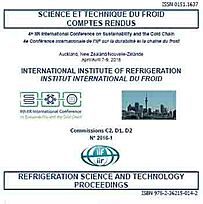
Document IIF
Possibilités d'application de la microtomographie aux rayons X pour caractériser la microstructure des pommes congelées pendant l'entreposage.
Applicability of X-ray microtomography for characterizing the microstructure of frozen apple during storage.
Auteurs : VICENT V., NDOYE F. T., VERBOVEN P., et al.
Résumé
X-ray microtomography (X-ray micro-CT) was applied to visualise the change of 3D microstructure during freezing of ‘Jonagold’ apple at a pixel resolution of 3.83 µm. To better understand the microstructure evolution during freezing, pore size distributions were carefully analysed. This work highlighted the applicability of X-ray micro-CT to visualise the microstructure evolution in frozen apple samples subjected to three different freezing protocols (at -6°C, -12°C, -20°C). Freezing process was done directly on cooling mounted on micro-CT system that allows one to follow the structure of the materials in frozen state. It was observed that slow rate of heat removal at -6°C damages cellular tissue of apple considerably as noted on the spatial irregularity of pores. Instead; slightly damaging of apple tissues was observed for the latter two freezing protocols (i.e. at -12°C and -20°C). From this study, we manage to show the application of X-ray micro-CT to reveal and quantify the 3D microstructure of frozen apple tissue during freezing.
Documents disponibles
Format PDF
Pages : 7
Disponible
Prix public
20 €
Prix membre*
Gratuit
* meilleur tarif applicable selon le type d'adhésion (voir le détail des avantages des adhésions individuelles et collectives)
Détails
- Titre original : Applicability of X-ray microtomography for characterizing the microstructure of frozen apple during storage.
- Identifiant de la fiche : 30017572
- Langues : Anglais
- Source : 4th IIR International Conference on Sustainability and the Cold Chain. Proceedings: Auckland, New Zealand, April 7-9, 2016.
- Date d'édition : 07/04/2016
- DOI : http://dx.doi.org/10.18462/iir.iccc.2016.0054
Liens
Voir d'autres communications du même compte rendu (63)
Voir le compte rendu de la conférence
Indexation
-
Thèmes :
Congélation des aliments;
Fruits - Mots-clés : Structure; Imagerie; Rayon C; Pomme; Congélation
-
Influence of 2.45 GHz microwave radiation suppl...
- Auteurs : ROUAUD O., SADOT M., CHEVALLIER S., et al.
- Date : 24/08/2019
- Langues : Anglais
- Source : Proceedings of the 25th IIR International Congress of Refrigeration: Montréal , Canada, August 24-30, 2019.
- Formats : PDF
Voir la fiche
-
Characterization of sorbet microstructure by us...
- Auteurs : MASSELOT V., BOSC V., BENKHELIFA H.
- Date : 24/08/2019
- Langues : Anglais
- Source : Proceedings of the 25th IIR International Congress of Refrigeration: Montréal , Canada, August 24-30, 2019.
- Formats : PDF
Voir la fiche
-
Effect of dynamic storage temperatures on micro...
- Auteurs : VICENT V., NDOYE F. T., VERBOVEN P., et al.
- Date : 24/08/2019
- Langues : Anglais
- Source : Proceedings of the 25th IIR International Congress of Refrigeration: Montréal , Canada, August 24-30, 2019.
- Formats : PDF
Voir la fiche
-
X-ray CT-based CFD study to investigate the coo...
- Auteurs : GRUYTERS W., WANG Z., VERBOVEN P., et al.
- Date : 24/08/2019
- Langues : Anglais
- Source : Proceedings of the 25th IIR International Congress of Refrigeration: Montréal , Canada, August 24-30, 2019.
- Formats : PDF
Voir la fiche
-
Freezewave H2020 project-microwave assisted fre...
- Auteurs : JHA P. K., JURY V., CHEVALLIER S., et al.
- Date : 06/04/2018
- Langues : Anglais
- Source : 5th IIR International Conference on Sustainability and the Cold Chain. Proceedings: Beijing, Chine, 6-8 avril 2018
- Formats : PDF
Voir la fiche
